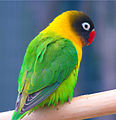Yellow-collared lovebird
| Masked Lovebird | |
|---|---|

| |
| Scientific classification | |
| Kingdom: | |
| Phylum: | |
| Class: | |
| Order: | |
| Family: | |
| Genus: | |
| Species: | A. personata
|
| Binomial name | |
| Agapornis personata Reichenow, 1887
| |
| File:Masked lovebird distribution.gif | |
| Native range in northeast Tanzania | |
The Masked Lovebird (Agapornis personata) is a bird species in the parrot family. They are native to northeast Tanzania.
The head of the nominate black-masked is a dark sooty black with a bright red beak. The wings are a dark green with a lighter underside. The breast and the nape of the neck are yellowish, and the flight feathers are black. Various color mutations exist, including blue, cobalt, slate, dilute slate and violet. The blue mutation reportedly occurs on its own in the wild while other mutations are a result of selective breeding amongst hobbyists. Masked lovebirds are known for the large white rings around each of its eyes (which give it the appearance of wearing a mask). The masked lovebird is one of the smaller lovebirds, compared to other species of Lovebirds. They are also reportedly more shy and reserved in comparison to the peach-faced lovebird. Their diet is mainly seed with fresh fruit and vegetables. The best fruit and vegetables to feed them are green and yellow. Do not feed them anything salted, or iceberg lettuce, or anything containing caffeine or chocolate. Avocado and other certain fruits can also harm them. Their average size is about 5-6 inches. You should place at least three toys in their cage so your bird won't get bored when you're not with them. If they live in a cage alone they will be more dependent on their owner, if they live with other lovebirds they will tend to ignore you more and pay attention to the other birds. Their cage should be at least 18" x 18"- if it is too small they will feel crowded. Lovebirds can make great pets if their owner is willing to spend time with them, especially if they are acquired and hand fed from a very young age.
Gallery
-
Masked Lovebird
-
Masked Lovebirds (blue colour mutation)


